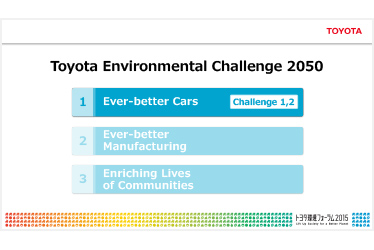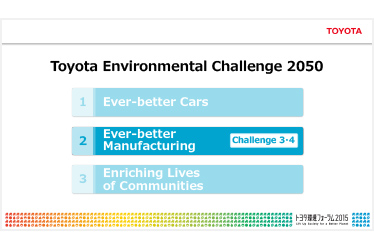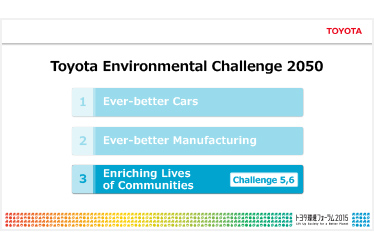Oct. 14, 2015
Toyota Unveils Bold New Environmental Targets
Toyota City, Japan, October 14, 2015―With the aim of contributing to global environmental sustainability, Toyota has developed an ambitious set of goals to be achieved over the next 35 years.
Addressing key global environmental issues such as climate change, water shortages, resource depletion, and degradation of biodiversity, the Toyota Environmental Challenge 2050 aims to reduce the negative impact of manufacturing and driving vehicles as much as possible. The challenge is composed of six individual challenges across three areas: Ever-better cars, ever-better manufacturing, and enriching lives of communities.
In addition, as a key step toward achieving these long-term targets, Toyota is announcing its Sixth Toyota Environmental Action Plan, which will be enacted between April 2016 and the end of March 2021.
| Ever-better cars | |
|---|---|
Reducing global average new-vehicle CO2 emissions by 90 percent by 2050 (compared to Toyota's 2010 global average)
|
|
Completely eliminating all CO2 emissions, including materials, parts and manufacturing, from the vehicle lifecycle
|
|
| Ever-better manufacturing | |
Zero CO2 emissions at all plants by 2050
|
|
Enacting effective wastewater management and minimizing water consumption, taking into account the conditions in each country and region
|
|
| Enriching lives of communities | |
Promoting global rollout of end-of-life vehicle treatment and recycling technologies developed in Japan by establishing two recycling projects in 2016
|
|
Promoting global rollout of conservation activities beyond the Toyota Group and its business partners by establishing three future-oriented global projects in 2016
|
|
Some specific examples of Toyota's efforts to meet these ambitious targets are given below.
- New Vehicles Zero CO2 Challenge
- Key activities and goals at present
-
- Developing next-generation automotive technologies and encouraging their widespread use from the standpoint of energy conservation and diversification of fuel sources
- Reducing global average new-vehicle CO2 emissions by more than 22 percent by 2020 (compared to Toyota's 2010 global average)
- Energy conservation
- Launching (worldwide, in 2014 and 2015) a new series of 14 engines that achieve top-level thermal efficiency and fuel efficiency improvement of more than 10 percent (JC08 cycle) over current models
- Developing and launching high-performance powertrains based on the Toyota New Global Architecture (TNGA), an innovative, integrated, development program for powertrain components and vehicle platforms
- Launching hybrid models in all categories on a global basis; exceeding cumulative sales of 8 million hybrids in July 2015
- Broadening the appeal of hybrids through improved performance and a broad product lineup; achieving sales of 1.5 million hybrids annually and 15 million hybrids cumulatively by 2020
- Achieving fuel efficiency of more than 40 km/L* (selected grades) with the new Prius, thanks to a more sophisticated hybrid powertrain and improvements stemming from TNGA
*Development target (JC08 test cycle); in-house measurements - Diversification of fuel sources
- Improving electrified powertrains
- Developing next-generation models based on hybrid technologies, which encompass all of the component technologies necessary for the development of environment-friendly cars and which facilitate the use of different fuel combinations.
- Pushing for further advances related to electrified powertrains in order to develop next-generation models; promoting development of next-generation batteries, such as solid-state batteries that have higher energy density, easier increase in voltage and excellent high-temperature durability, in order to improve the range of EVs and the electric range of PHVs
- Promoting the downsizing and improvement of power control units in hybrids and PHVs, etc.; focusing development resources on the commercial application of silicon carbide power semiconductors (jointly developed with Denso Corporation and Toyota Central R&D Labs., Inc.) that can improve the fuel efficiency of hybrids by 10 percent.
- Fostering a hydrogen-based society
- Launching the hydrogen-powered Mirai in Japan, followed by Europe and the U.S.; promoting widespread use of fuel cell vehicles, including making 5,680 fuel cell patents freely available and collaborating with other automakers to support the development of hydrogen infrastructure
- Fostering a hydrogen-based society by putting fuel cell vehicles on the road; aiming to achieve annual global sales of over 30,000 fuel cell vehicles―a ten-fold increase from 2017 production volume―around or after 2020; boosting production and improving production technology to meet this dramatic sales increase, and offering a broader lineup
- Working with governments and infrastructure businesses around the world to promote the growth of hydrogen infrastructure. In Japan, selling at least 1,000 fuel cell vehicles per month (well in excess of 10,000 per year) around or after 2020 to help foster a hydrogen-based society, considering Tokyo's role as host city for the 2020 Summer Olympics and Paralympics
- Beginning sales of fuel cell buses in small numbers by early 2017, focusing on Tokyo; preparing to sell over 100 fuel cell buses ahead of the 2020 Summer Olympics and Paralympics in Tokyo
- Working with other Toyota Group companies and hydrogen infrastructure companies toward using hydrogen to power low-CO2 manufacturing; conducting trials ahead of application and commercialization of such methods
- Improving electrified powertrains
- Life Cycle Zero CO2 Emissions Challenge
- Key activities and goals at present
-
- Cutting total vehicle lifecycle CO2 emissions, including materials, parts and manufacturing
- Developing, designing and using low-CO2 materials; reducing the amount of material and the number of parts used in order to cut overall CO2 emissions involved in manufacturing materials
- Using recycled bio-materials more widely; designing vehicles for easy disassembly; other initiatives focusing on environment-conscious vehicle designs
- Plant Zero CO2 Emissions Challenge
- Key activities and goals at present
- Reducing CO2 emissions through day-to-day continuous improvements and introduction of low-CO2 production methods; cutting CO2 emissions per car from new plants and new production lines to roughly half of 2001 levels by 2020, and roughly a third by 2030; using renewable energy and hydrogen-based power generation to to completely eliminate CO2 emissions from our plants by 2050
- Implementing low-CO2 production methods/day-to-day continuous improvements
- Developing and introducing new, simple and slim production methods; optimizing energy usage and introducing low-burden transportation and processing methods around the world
- Using new technology to ensure that production process-related CO2 emissions per vehicle manufactured at our new plant in Mexico are at least 40 percent lower than 2001 levels when the plant goes online in 2019
- Using renewable energy and hydrogen
- Using our experience with fuel cell technology (particularly combustion and electricity generation) to develop hydrogen-based power generation methods for use in production; beginning testing on FCV production lines by 2020
- Using wind power produced on-site at our Tahara Plant by around 2020
- Exclusively using locally-produced wind power, biomass and hydroelectric power to generate electricity at our plants in Brazil (Toyota do Brasil) from 2015
- Implementing low-CO2 production methods/day-to-day continuous improvements
- Challenge of Minimizing and Optimizing Water Usage
- Key activities and goals at present
-
- Reducing water consumption in existing manufacturing processes; introducing technologies that reduce industrial water consumption through rainwater use; improving water recycling rates in manufacturing processes, and recycling plant wastewater
- Improving local environments by ensuring (by our own standards) that plant wastewater is cleaner than local river water
- Challenge of Establishing a Recycling-Based Society and Systems
- Key activities and goals at present
-
- Using resources more efficiently by 1) using eco-materials, 2) using parts for longer, 3) improving recycling technologies, and 4) building cars from end-of-life vehicles
-
- Promoting global rollout of end-of-life vehicle treatment and recycling technologies developed in Japan by establishing two projects
-
-
- Toyota Global 100 Dismantlers Project
- Safe and eco-friendly automobile dismantling facilities certified by Toyota will be established around the world for the development of a scheme that optimizes collection and processing of resources from end-of-life vehicles. The first facility was a joint venture established in Beijing in 2014.
-
- Toyota Global Car-to-Car Recycle Project
- Recycling technologies and systems developed in Japan will be rolled out globally, turning end-of-life vehicles back into useful resources for the production of vehicles.
-
- Challenge of Establishing a Future Society in Harmony with Nature
- Key activities and goals at present
- Expanding Toyota's long-standing conservation activities in the areas of forestry, environmental grants, and environmental education; sharing our knowledge and experience gained from these activities through three future-oriented projects:
-
- Toyota Green Wave Project
- connecting with local communities
A series of mutually affiliated tree-planting and habitat restoration and preservation activities run by Toyota and Toyota Group companies. Cooperation will be sought from local governments and businesses, as well as suppliers and sales companies, to expand the scope of activities and contribute to improving the natural environment. This project will draw on Toyota's experience in planting a cumulative total of 8.6 million trees over more than 10 years in Hebei Province, China, which is suffering from desertification, as well as at Toyota plants in Japan and other countries. -
- Toyota Today for Tomorrow Project
- connecting with the world
A long-standing environmental grant program that will be strengthened on a global scale. Toyota will launch a project fostering global conservation, in cooperation with various like-minded organizations around the world. -
- Toyota Education for Sustainable Development Project
- connecting to the future
Based on the concept of training people to take care of the environment, this series of environmental education programs will be significantly expanded using conservation sites owned by Toyota in Japan. Overseas, an Environmental Education Center has opened in China, followed by one in Thailand.
-
- Toyota Environmental Challenge 2050 website
- http://www.toyota-global.com/sustainability/environment/challenge2050/index.html
- Sixth Toyota Environmental Action Plan website
- http://www.toyota-global.com/sustainability/environment/plan/sixth_plan/index.html







